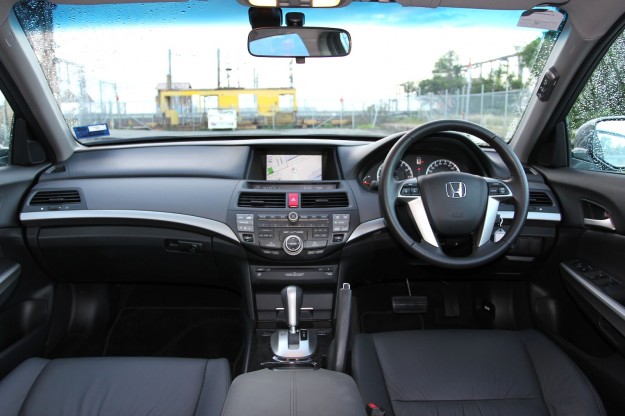
An all-new Honda Accord may be headed our way in mid 2013, but the outgoing Japanese full-size sedan remains a hugely capable contender in the segment dominated by Australia’s locally made Toyota Camry.
Since its launch in 2008, the eighth-generation Honda Accord has been updated twice (in 2010 and 2011), and in May 2012 copped a price cut that saw the entry-level VTi variant slashed to $28,190 – making it the most affordable ‘large car’ on the market and, somewhat paradoxically, $2150 cheaper its mid-sized sibling, the Honda Accord Euro.
The base model is joined in the three-pronged 2013 Honda Accord line-up by the mid-range $37,190 VTi-LN (tested here) and the more powerful $47,290 V6L.

Among the most impressive elements of the Honda Accord VTi-LN is its comprehensive equipment list, which compares closely with the spec of the $36,990 Hyundai i40 Elite and $39,990 Toyota Camry Atara SL.
Standard features include 17-inch alloys (with full-size alloy spare), auto headlights and wipers, foglights, sunroof, dual-zone climate control, cruise control, eight-way power driver’s seat with lumbar adjust, heated front seats, leather upholstery, reversing sensors, rear-view camera, satellite navigation, and a 270-watt audio system with subwoofer, six-disc CD stacker, AUX and USB ports, and Bluetooth phone connectivity (but no audio streaming).
Six airbags (dual front, side and curtains) and electronic stability control headline a basic but sound safety package.

Powering the Accord VTi-LN is a 2.4-litre four-cylinder petrol engine producing 133kW (at 6500rpm) and 226Nm (at 4500rpm). A five-speed automatic transmission sends power to the front wheels.
Like most Honda engines the Accord’s four-pot is a sweet-revving unit that seems happiest north of 5000rpm on the approach to its 6800rpm redline. It doesn’t sound or feel tortured with the tacho needle pointing past 12 o’clock, but rather embraces the moment, sings enthusiastically without becoming over-eager, and pulls with decent force.
The flipside is down the other end, where progress is slow below 3000rpm, making acceleration off the line and from lower speeds more of an effort – something those downsizing from traditional six-cylinder large cars will notice.

While it’s at least one ratio short of its newer rivals, the Accord’s five-speed auto is still a great match for both the car and the engine. The intuitive gearbox picks its shift points cleverly, keeping the engine in its higher-revving sweet spot when confronted by inclines or more aggressive throttle applications.
Our test car consumed 10.7 litres per 100km over the course of a week – a decent return given Honda’s official claim of 8.7L/100km on the combined cycle.
The Honda Accord rides well around town where the roads are flatter and the surfaces better maintained, and its composure at higher speeds is also impressive. Concrete surfaces with multiple road joins can feel choppy and also provoke the most noticeable noise from the tyres.

The Accord is at its most unsettled over undulations – rolling bumps common on country roads – which cause it to bounce from side to side and temporarily lose its typically balanced feel.
There’s an encouraging solidity to the steering feel with the wheel at the straight-ahead position, making the Honda Accord a confident highway cruiser. Inputs in either direction reveal more play away from that centre position, however, feeling slack mid-corner and lacking the confidence-inspiring consistency delivered by its best rivals.
Despite being an older-style hydraulic system, the steering still has an easy feel around the city, making light work of parking and low-speed manoeuvres. Dynamically, the smaller Accord Euro takes the points for its keener, more consistent steering and more settled ride on rougher roads.

Sliding inside the cabin reveals a conservative cockpit with excellent fit and finish quality. But it is showing its age. Hard plastics are used across all surfaces but the doorsills, and the grey colour scheme is monotonous.
While its functions are simple to use, the Accord’s infotainment screen looks prehistoric compared with its rivals, and is most annoying at night when its reflection appears as a big white square in the centre of the windscreen. The massive ‘Enter’ button/dial used to navigate its controls and the chunky Bluetooth panel tacked onto the A-pillar are both anti-ergonomic and detract from the interior’s otherwise pervading feeling of quality.

The driver’s seat is comfortable, offering good torso and under-thigh support and lots of adjustment to suit different driver sizes and seating positions, while visibility is also decent front and back.
Rear-seat passengers under six-foot won’t have issues with headroom, and there’s acres of legroom for even taller travellers relegated to the second row. A well-angled, long seat base and smooth leather ensure long-distance comfort for those in the back.
Storage throughout the cabin is generous, headlined by the deep glovebox and centre console designs and useful door bins.

The Accord’s 450-litre boot leaves it trailing its full-size sedan competitors, and while the rear bench can be folded forwards to expand its cargo capacity, it does so in one piece, rather than splitting 60:40 as is more common and more versatile.
Like all Honda vehicles sold in Australia, the Accord is covered by a three-year/100,000km warranty.
It may not be long for this world, but the eighth-generation Honda Accord is memorable for its refined drivetrain, strong value and comfortable interior. If you can look past the dated interior and some dynamic limitations, now could be an opportunistic time to encourage dealers to sharpen their pencils even further on the price, with the launch of the new model imminent.





